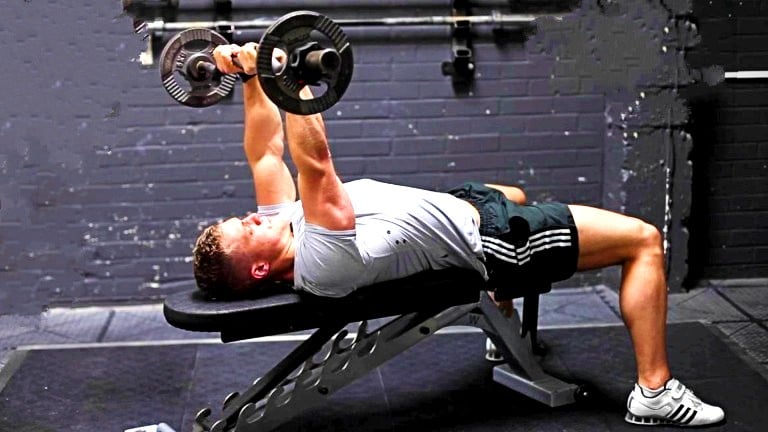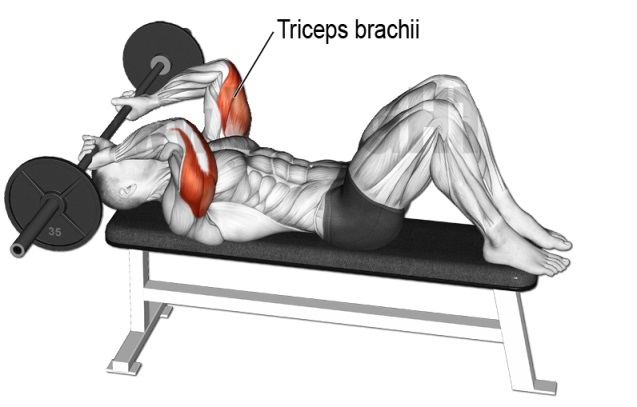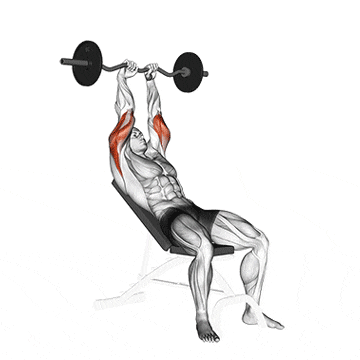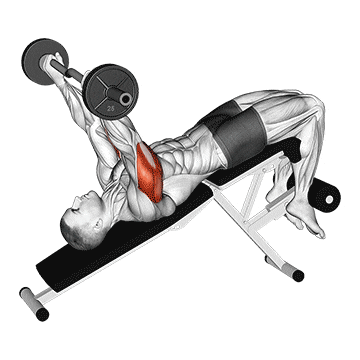EZ Bar Skull Crusher, is one of the best variations of the skull crushers that is usually done on a flat bench with an Ez-bar. You can also modify the bench position to either incline or decline to do the same.
The unique shape of the EZ bar allows for a more comfortable and supportive grip, lessening stress on the hands and elbows.
The term “skull crusher” derives from the exercise’s fundamental mechanics of lowering the weight towards the skull.
They are a popular type of skull crusher among gym goers and bodybuilders to train tricep. There are many other ways to do it.
- Incline Ez Bar Skull Crusher
- Decline Ez Bar Skull Crusher

- EZ Bar Skull Crusher Muscles Worked
- How To Do Ez Bar Skull Crusher
- Form And Tips
- Ez Bar Skull Crusher Variations
- 1. Incline Ez Skull Crusher
- 2. Decline Ez Bar Skull Crusher
- FAQs
- What muscles does the EZ bar skull crusher work?
- Is it better to do skull crushers with an EZ bar or a straight bar?
- How often should I do EZ bar skull crushers?
- What grip is best for skull crushers?
- Dumbbell vs EZ bar skull crushers
- References
EZ Bar Skull Crusher Muscles Worked
- Primary muscles worked: the triceps brachii, with a particular emphasis on the long head of the muscle.
- Synergist and stabilizer muscles: forearm muscles, Pectoralis Major, Lats, deltoids and Core muscles

How To Do Ez Bar Skull Crusher
- Lie down on a flat bench with your feet firmly planted on the ground.
- Grasp the Ez bar with an overhand grip (palms facing down) that is slightly narrower than shoulder-width apart.
- Make sure you’ve got the right weight on there – no need to be a hero. Be Superhero. Smart.
- Once you’re settled, do a quick body check. Your head, upper back, and butt should all be touching the bench. Comfy? Good.
- Before you start, make sure your upper arms are straight up, perpendicular to the floor.
- Slowly lower the bar towards your forehead. No need to rush – slow and steady wins the race. When you get to the bottom, hold it there for a sec.
- Then, push that bar back up to where you started. Feel the burn!
- Complete the 3-4 sets of 8–12 repetitions.
Form And Tips
- Avoid lowering the weight too close to your face or forehead. This can put too much strain on the elbows and increase the risk of getting hurt.
- You should do the whole movement slowly and carefully, especially when the weight moving down.
- Don’t let the barbell fall too quickly or bounce off.
- Exhale during the concentric phase (when lifting the barbell) and inhale during the eccentric phase (when lowering the barbell).
- Keep your elbows close to your head and pointing upward.
- Keep your shoulders and upper arms fixed. All the movement should be in your elbows.
- Avoid allowing your elbows to flare out to the sides or drift forward.
- Don’t lock your elbows at the top of the movement. This can put stress on your elbows and cause injury.
- Pause for a moment at the bottom of the movement. This will help to stretch the triceps and get a better workout.
- Start light, add weight gradually, and always keep the movement under full control.
Ez Bar Skull Crusher Variations
The EZ bar skull crusher can be performed in different ways by changing the bench position to effectively target the triceps.
- If you’re new to doing skull crusher, you can make the exercise easier by using a lighter weight.
- If you want a more advanced variation to work different muscle fibers in the tricep, try Incline and decline Ez bar skull Crushers.
Know More: 7 Best Barbell Triceps Exercises For Mass And Strength
1. Incline Ez Skull Crusher
The incline skull crusher helps to build muscle and strength in all three tricep heads. To do it Set an incline bench at around 30–45 degrees.
When you’re on an incline, your arms are angled back a bit more. This gives your triceps a deeper stretch of the triceps during the eccentric (lowering) phase and a more intense contraction during the concentric (lifting) phase.
Adding incline skull crushers to your tricep workout routine can help you get stronger and overcome plateaus.

2. Decline Ez Bar Skull Crusher
Decline skull crushers are a variation of the traditional skull crusher exercise performed on a decline bench.
The decline angle enhances the stretch on the triceps during the eccentric phase and allows for a deeper contraction during the concentric phase. This increased range of motion can lead to greater muscle activation and development.

FAQs
What muscles does the EZ bar skull crusher work?
The EZ bar skull crusher works the triceps, specifically the long head of the triceps.
Is it better to do skull crushers with an EZ bar or a straight bar?
Both variations are effective at targeting the triceps muscle. Some people may find the EZ bar more comfortable and ergonomic, thanks to its angled grips that reduce strain on the wrists and elbows. On the other hand, the straight bar allows for a slightly greater range of motion, potentially providing a deeper stretch in the triceps.
How often should I do EZ bar skull crushers?
It’s okay to do EZ bar skull crushers 2-3 times a week.
What grip is best for skull crushers?
A shoulder-width apart or slightly narrower is the best grip for skull crushers.
If you feel the close grip is too uncomfortable on your wrists, you can try using a neutral grip, with your palms facing each other, by using a dumbbell.
Dumbbell vs EZ bar skull crushers
Dumbbell skull crushers allow for greater stability and each arm to work independently, while the EZ bar version provides a more ergonomic grip. Choose based on personal comfort and training goals.
References
- Boehler B, Porcari JP, Kline D, Hendrix R, Foster C, Anders M. ACE-sponsored research: Best triceps exercises. American Council on Exercise.
- Borges E, Mezêncio B, Pinho J, Soncin R, Barbosa J. Resistance training acute session: pectoralis major, latissimus dorsi and triceps brachii electromyographic activity. J Phys Ed Sport. 2018;2018(02):648-653. doi:10.7752/jpes.2018.02095
- Shuttlewood K, Beazley J, Smith CD. Distal triceps injuries (Including snapping triceps): A systematic review of the literature. World J Orthop. 2017;8(6):507-513. doi:10.5312/wjo.v8.i6.507

Manish is a NASM-certified fitness and nutrition coach with over 10 years of experience in weight lifting and fat loss fitness coaching. He specializes in gym-based training and has a lot of knowledge about exercise, lifting technique, biomechanics, and more.
Through “Fit Life Regime,” he generously shares the insights he’s gained over a decade in the field. His goal is to equip others with the knowledge to start their own fitness journey.
